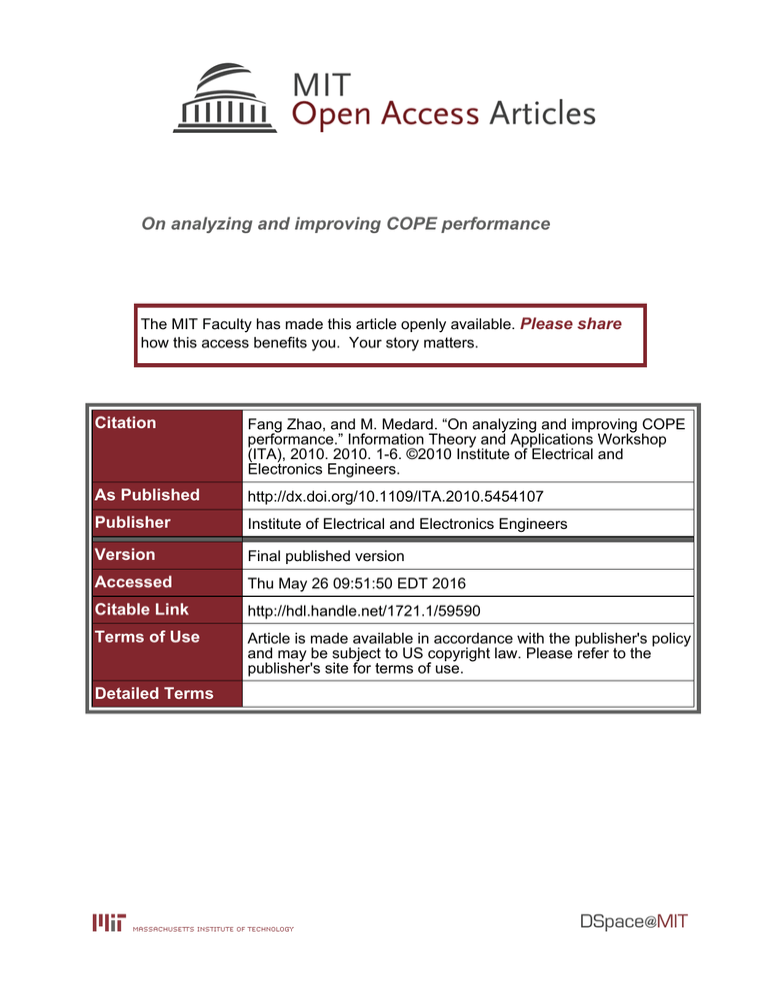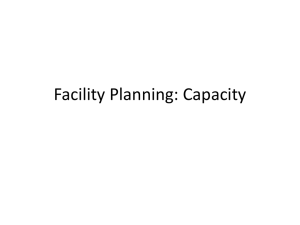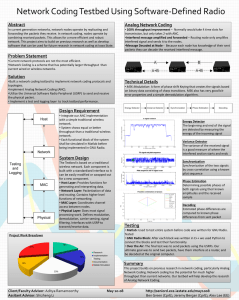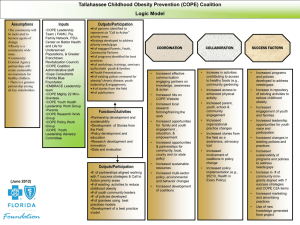On analyzing and improving COPE performance Please share
advertisement

On analyzing and improving COPE performance
The MIT Faculty has made this article openly available. Please share
how this access benefits you. Your story matters.
Citation
Fang Zhao, and M. Medard. “On analyzing and improving COPE
performance.” Information Theory and Applications Workshop
(ITA), 2010. 2010. 1-6. ©2010 Institute of Electrical and
Electronics Engineers.
As Published
http://dx.doi.org/10.1109/ITA.2010.5454107
Publisher
Institute of Electrical and Electronics Engineers
Version
Final published version
Accessed
Thu May 26 09:51:50 EDT 2016
Citable Link
http://hdl.handle.net/1721.1/59590
Terms of Use
Article is made available in accordance with the publisher's policy
and may be subject to US copyright law. Please refer to the
publisher's site for terms of use.
Detailed Terms
On analyzing and improving COPE performance
Fang Zhao, Muriel Médard
Research Laboratory of Electronics
Massachusetts Institute of Technology, Cambridge, MA 02139, USA
E-mail: {zhaof, medard}@mit.edu
Abstract—COPE is a new architecture for unicasts in wireless
mesh networks that employs opportunistic network coding to
improve total throughput. Katti et al. showed through experiments that this system significantly improves the throughput of
wireless networks with UDP traffic, and several attempts have
been made to analyze the COPE performance. However, they
are not completely satisfactory. In this paper, we give a new
analysis of COPE, and argue that the key to COPE’s success lies
in the interaction between COPE and the MAC protocol. The
local fairness enforced by the MAC protocol among competing
nodes play an important role here. Based on the analysis, we
also propose a simple modification to the COPE system that can
further improve the network throughput.
I. I NTRODUCTION
The introduction of network coding in 2000 [1] has the
potential to revolutionize the way we operate networks. The
broadcast nature of the wireless medium renders network
coding particularly useful. One of the first practical network
coding systems for wireless networks is COPE, introduced by
Katti et al. [2], [3]. COPE is a new forwarding architecture
for wireless network that inserts a coding shim between the
IP and MAC layers, which identifies coding opportunities and
benefits from them by forwarding multiple packets in a single
transmission.
The outstanding performance of COPE has generated a
lot of research interests. Some researchers tried to model
the COPE system and analyze its performance [4], [5], and
we will discuss these in more details in Section II. Others
proposed new coded wireless network systems based on the
idea of COPE. Dong et al. [6] proposed loop coding, which
allows receivers to temporarily store coded packets for future
decoding. Omiwade et al. [7] proposed BFLY, a localized
network coding protocol that allows intermediate nodes not
only to XOR packets together (as in COPE), but also to
forward coded packets. Chaporkar et al. [8] presented a joint
network coding and scheduling schemes to optimize network
throughput.
So far, the attempts to model and analyze COPE’s performance are not completely satisfactory. In this paper, we try
to explain the COPE performance curve by closely examining
one coding structure, and we show that the throughput gain
is a result of the interaction between COPE and the MAC
protocol. The local fairness enforced by the MAC protocol
among competing nodes when distributing bandwidth plays
an important role here. In addition, based on our observations
in the analysis, we propose a simple modification to the COPE
system that can further improve the network throughput.
The rest of this paper is organized as follows. We first
introduce the basic idea of COPE and existing work on COPE
performance analysis in Section II. Section III presents our
analysis of COPE’s performance under UDP traffic. In Section
IV, we propose a simple improvement to COPE, and the paper
is concluded in Section V.
II. BACKGROUND
A. The COPE system
We first explain the basic idea of COPE by using the
Alice-and-Bob network shown in Fig. 1. Here, Alice and Bob
want to exchange a pair of packets via a router, R. In a
traditional routing network, Alice and Bob would first send
their packets to R, and then R forwards the two packets to their
respective destinations in two time slots. This process takes 4
transmissions. However, if network coding is allowed in the
router, after R has received the two packets from Alice and
Bob, it can XOR the two packets together and broadcast this
new packet. When Alice and Bob receive the XOR-ed packet,
they can obtain each other’s packet by XOR-ing again with
their own packet. In this way, we utilize the broadcast nature
of the medium and save one transmission, which can be used
to send additional data, increasing the network throughput.
ϭ
Z
Ϯ
ϰ
ϯ
;ĂͿZŽƵƚŝŶŐ
ϭ
Z
Ϯ
ϯ
;ďͿKW
Fig. 1. Example of how COPE increases the throughput in the Alice-and-Bob
wireless network.
Even larger coding gain can be obtained when more packets
are coded together. For example, consider the cross network
shown in Fig. 2. Here, nodes 1, 2, 4, 5 each has a packet
to be sent to the opposite node via node 3 in the middle. In
addition, when node 1 sends, nodes 2 and 4 can overhear the
transmission. Same goes for nodes 2, 4, and 5. It is easy to see
that in conventional routing network, it takes 8 transmissions
for the 4 packets to be delivered. However, in COPE, we can
first let the four source nodes send their packets to node 3,
and then node 3 XORs all of them together and broadcast the
coded packet. Since every node has its own packet and the two
packets overheard from the transmissions of their neighbors, it
can derive the packet destined to it from the XOR-ed packet.
ϭ
ϯ
Ϯ
ϰ
ϱ
Fig. 2.
Cross network.
Therefore, in COPE, the process only takes 5 transmissions,
and we save 3/8 of the bandwidth as compared to the routing
case.
In summary, COPE employs network coding to utilize the
broadcast nature of the wireless channel. The coding here is
simple XOR, and the decoding is done at the next hop, i.e.,
there is no forwarding of the coded packets. Implementation of
the COPE system involves many practical issues, as explained
in [2], [3]. Here, we only summarize the three main techniques
incorporated in COPE:
1) Opportunistic Listening: Since the wireless channel
is a broadcast medium, and the nodes are equipped
with omni-directional antennae, COPE makes the nodes
snoop on all communications over the wireless medium
and store the overheard packets for a limited period. In
addition, each node broadcasts reception report to its
neighbors about which packets it has stored, to enable
their neighbors to find coding opportunities.
2) Opportunistic Coding: Based on its knowledge of what
the neighbors have, a node decides on what packets
to code together. The rule it follows is to maximize
the number of native packets delivered in a single
transmission, while ensuring that each intended nexthop
has enough information to decode its native packet.
3) Learning Neighbor State: In addition to using the
reception reports to find out what packets a neighbor has,
a node may also need to guess whether a neighbor has a
particular packet. This is done intelligently by leveraging
the routing computation. In the absence of deterministic
information, COPE estimates the probability that a particular neighbor has a packet as the delivery probability
of the link between the packet’s previous hop and the
neighbor.
COPE has been implemented by Katti et al. [3] in a 20node wireless mesh network, and tested with both TCP and
UDP traffic. In their tests, TCP does not show any significant
improvement with coding, and this is due to TCP’s reaction
to collision-related losses. Due to collisions at the bottleneck
nodes, the TCP flows suffer timeouts and excessive back-off.
Thus, the bottleneck nodes never see enough traffic to make
use of coding. Few coding opportunities arise, and hence the
throughput performance is the same with and without coding.
On the other hand, with UDP traffic, COPE can provide
Fig. 3. COPE can provide a several-fold (3-4x) increase in the throughput
of wireless ad hoc networks with UDP flows. This figure is taken from [3].
a several-fold increase in the throughput of wireless ad hoc
networks. Fig. 3, taken from [3], demonstrates the throughput
gain of the COPE system for the 20-node testbed for UDP
traffic with randomly picked source-destination pairs, Poisson
arrivals, and heavy-tail size distribution.
B. Existing analysis of COPE
The good performance of COPE with UDP traffic has
attracted the attention of many researchers, and several attempts have been made to model COPE and explain the huge
throughput gain.
Sengupta et al. formulated the throughput computation in
a wireless network coding system into a linear programming
(LP) problem [4]. Their formulation only considers the coding
cases involving two packets, the scenario illustrated in Fig. 1.
However, from the statistics in [3], we see that coded packets
consisting of more than two native packets plays an important
role in the throughput gain. In addition, the LP formulation
does not capture the interaction between COPE and the MAC
protocol very well. The LP problem enforces fairness among
the overall flows, whereas in reality, fairness is enforced by
the MAC protocol on a local scale. These differences lead
to discrepancies between the experimental results and that
predicted by the theoretical formulation.
Le et al. [5] tries to understand COPE by focusing on one
coding structure at a time. A coding structure includes one
coding node as well as the one-hop predecessor nodes and
the one-hop successor nodes of the associated coding flows.
The networks in Fig. 1 and Fig. 2 are both examples of single
coding structures. The key performance measure they use is
the encoding number, i.e., the number of packets that can
be encoded by a coding node in each transmission. They
upper bound the throughput gain in COPE by 2n/(n + 1)
for a general wireless network, where n is the maximum
encoding number in one of its coding structures. Clearly, this
upper bound is less than 2, which is much smaller than the
throughput gain observed in Fig. 3. This is due to the fact that
the analysis in [5] only deals with coding gain, but does not
take into consideration the coding+MAC gain.
III. COPE PERFORMANCE ANALYSIS
BWa = 0.25, BWb = 0.25, BWr = 0.5.
In this case, the total throughput of the system is 0.5.
As the offered load increase beyond 0.5, the system will
not be able to handle all the traffic. Queues at some
of the nodes will grow, and packets are going to be
dropped. Consider the saturation case, when the offered
load is very large, all the nodes have backlogs. They are
constantly competing for the channel. In this case, the
MAC protocol will allocate the channel fairly among the
three nodes, i.e.,
BWa = BWb = BWr = 1/3.
Note that the total throughput of this system is always
equal to BWr , thus, the saturation throughput is 1/3.
0.7
0.6
0.5
Total throughput
The existing analysis of COPE fails to address two important aspects of the performance curves.
1) The magnitude of the throughput gain in COPE experiments is much larger than that predicted by the analysis;
2) As shown in Fig. 3, for both the COPE and the nonCOPE systems, the throughput first increases linearly
with the offered load. After reaching a peak point, the
throughput decreases with increased load, and finally
settles down to a saturation level. On the contrary, the
performance curves derived from the existing theoretical
formulations have a different shape. The throughput rises
with increased load until it reaches a saturation level,
and further increase in load does not affect the total
throughput by much.
These discrepancies motivate us to take a closer look at the
COPE system. We find out that the key to explain the COPE
performance curves lies in the interaction between coding and
the MAC protocol, and the local fairness enforced by the MAC
protocol when it assigns bandwidth to competing nodes.
To understand this, we first look at the simple Alice-andBob network shown in Fig. 1. Here, we assume that the three
nodes in the network share the wireless channel, and the
total bandwidth is 1. Flows of size 0.01 are originated from
node A/B, and are to be sent to node B/A, respectively. The
relay node, R, does not generate any traffic. By increasing
the number of flows, the total offered load to the network is
increased. Also, the probability that a flow is generated by A
or B is equal. We denote the bandwidth allocated to nodes A,
B, and R as BWa , BWb , and BWr , respectively. The wireless
channel is lossless.
• Routing (non-COPE) case: When the offered load is
very small, every node can get enough bandwidth to
transfer what they have, and the total throughput grows
linearly with the offered load. The bandwidth demand for
the relay node is equal to the sum of the sending rates
at A and B, and the total throughput of the system is
always equal to BWr . The throughput reaches its peak
when the channel bandwidth is completely used up, i.e.,
0.4
0.3
0.2
0.1
COPE
Routing
0
0
0.5
1
Offered load
1.5
2
Fig. 4. Throughput for COPE and non-COPE systems in an Alice-and-Bob
network with cross traffic only.
•
Now, we look at the transition stage where the offered
load is between 1/2 and 2/3. For simplicity, assume
symmetric load for nodes A and B, and we denote it by
l. If the assigned bandwidth for A and B is less than that
required to clear their queues, they would be constantly
requesting for the channel. This situation is the same as
that in the saturation stage, and they will be allocated
1/3 bandwidth each. However, since their demand is less
than 1/3, they won’t have a backlog in this case. This is a
contradiction, therefore, nodes A and B will be assigned
bandwidths l, and the bandwidth assigned to R is then
equal to 1 − 2l. The complete throughput curve is shown
in Fig. 4.
Coding (COPE) case: When coding is allowed at the relay node, if the loads at A and B are perfectly symmetric,
every packet delivered by R generates a throughput of 2
packets. Similar to the routing case, when the offered load
is small, every node gets its required bandwidth, and the
throughput grows linearly with offered load until the total
bandwidth is used up, i.e.,
BWa = BWb = BWr = 1/3.
Since every transmission by R delivers two packets, the
peak throughput of the COPE system is 2/3. When the
offered load is increased further, packets starts to get
dropped by A and B, however, the bandwidth allocation
remains the same in the saturation stage, and the total
throughput stays at 2/3. This throughput curve is also
plotted in Fig. 4.
We next consider the cross network shown in Fig. 2. Assume
symmetric traffic is generated at the four side nodes, 1, 2, 4,
and 5, and is to be delivered to the opposite nodes. Also, when
node 1 transmits, nodes 2 and 4 can overhear the transmission,
and they store the overheard packets for future decoding. Same
goes for the other three nodes. The curves in Fig. 5 show
0.8
0.7
0.7
0.6
0.6
Total throughput
Total throughput
0.8
0.5
0.4
0.3
0.5
0.4
0.3
0.2
0.2
COPE
Routing
0.1
0
0.5
1
Offered load
1.5
COPE
Routing
2
0.1
0
0.5
1
Offered load
1.5
2
Fig. 5. Throughput for COPE and non-COPE systems in a cross network
with cross traffic only.
Fig. 6. Throughput for COPE and non-COPE systems in a cross network
with cross traffic and traffic generated at the center node.
the throughput performance for this network with and without
coding.
• Routing (non-COPE) case: Similar to the Alice-andBob network, the total throughput first increases linearly
with the offered load until it reaches the peak where
BW1 = BW2 = BW4 = BW5 = 1/8, BW3 = 1/2,
and total throughput is 1/2. The throughput then drops
when offered load is increased further until it reaches the
saturation stage where each node is allocated a bandwidth
of 1/5, and the total throughput is also equal to 1/5.
• Coding (COPE) case: When the load at the four side
nodes are perfectly symmetric, the relay node 3 can
code four packets together every time it transmits. The
throughput of this system peaks at 4/5 when the offered
load at each side node is equal to 1/5. The throughput
then remains at this level when offered load is further
increased.
As we can see, when more flows are involved in the coding
structure, the throughput gain becomes larger. This gain is not
just due to coding, but also due to the fact that the MAC
protocol allocates bandwidth among competing node fairly.
The throughput of the system is limited by the bandwidth at
the bottleneck node. With coding, the bottleneck node drains
it queue multiple times faster than that in the non-coding
case, thus resulting in the significant throughput gain. Even
larger throughput gain can be obtained if the coding structure
involves more than four flows, but they rarely happen in a
practical system.
In the above simple models, we only considered cross traffic
and all flows can be coded together. What happens when there
exist unicast flows that cannot be coded with any other flow?
To answer this question, we consider the cross network where
in addition to the traffic generated by the side nodes, there
are also flows generated by the center node, node 3, to be
sent to one of the side nodes. The throughput performance of
the COPE and non-COPE systems for this scenario is plotted
in Fig. 6. As we can see, in the coded system, the total
throughput drops after reaching the peak. This is because the
traffic generated by the center node cannot be coded with any
other packets, and the bandwidth used to send these ‘unicast’
packets are less efficiently used as compared to that used
for sending the coded packets. As more and more flows are
generated by node 3, these ‘unicast’ packets take up more
and more bandwidth at the bottleneck node, reducing the total
throughput.
The curves in Fig. 6 resembles that in Fig. 3 both in
shape and in the magnitude of gain. As in the experiments,
the largest gains are observed when the non-COPE curve
has started dropping from the peak, and the COPE curve
has yet to drop. Although our analysis only focuses on one
coding structure, we believe the performance of COPE in
a general network follows the same trend. This is because
in a practical network, the throughput is limited by a few
bottleneck nodes (coding structures). Therefore, by closely
examining one coding structure, we can understand what really
causes the COPE system behave in such a way. As mentioned
previously, the key factor here is the interaction between COPE
and the MAC and also the the local fairness enforced by the
MAC protocol.
IV. I MPROVEMENTS ON COPE
Our observation in the previous section leads to a simple
improvement of COPE that can further increase the network
throughput. Recall that in the case when there are both cross
traffic and traffic originated from the center node (Fig. 6), the
reason why the COPE curve drops is because the center node
has to use some of its bandwidth to take care of the ‘unicast’
packets, which are less efficient in terms of throughput. To
improve the total throughput, we would like to give higher
priority to coded packets, as they help to drain the queue
YƵĞƵĞĂƚƚŚĞĐŽĚŝŶŐŶŽĚĞ
͙
0.8
WϱϮ WϰϮ WϯϮ WϮϮ WϭϮ Wϱϭ Wϰϭ Wϯϭ WϮϭ Wϭϭ
0.7
^ĞƋƵĞŶĐĞŽĨƉĂĐŬĞƚƐƐĞŶƚ
WϯϮ Ϯ
Wϯϭ ϭ
Fig. 7. An example of queue status and packets sent in a cross network with
COPE.
Total throughput
͙
0.6
ϭсWϭϭнWϮϭнWϰϭнWϱϭ
ϮсWϭϮнWϮϮнWϰϮнWϱϮ
0.5
0.4
0.3
sŝƌƚƵĂůƋƵĞƵĞƐĂƚƚŚĞĐŽĚŝŶŐŶŽĚĞ
͙
Wϭϱ Wϭϰ Wϭϯ WϭϮ Wϭϭ
͙
WϮϱ WϮϰ WϮϯ WϮϮ WϮϭ
͙
Wϯϱ Wϯϰ Wϯϯ WϯϮ Wϯϭ
͙
Wϰϱ Wϰϰ Wϰϯ WϰϮ Wϰϭ
͙
Wϱϱ Wϱϰ Wϱϯ WϱϮ Wϱϭ
^ĞƋƵĞŶĐĞ ŽĨ ƉĂĐŬĞƚƐ ƐĞŶƚ
^ĞƋƵĞŶĐĞŽĨƉĂĐŬĞƚƐƐĞŶƚ
͙
ϱ
ϰ
ϯ
Wϯϭ Ϯ
ϭ
Modified COPE
COPE
Routing
0.2
0.1
0
0.5
1
Offered load
1.5
2
Fig. 9. Throughput for COPE, modified COPE, and non-COPE systems in
a cross network with cross traffic and traffic generated at the center node.
ϭсWϭϭнWϮϭнWϰϭнWϱϭ
ϮсWϭϮнWϮϮнWϰϮнWϱϮ
ϯсWϭϯнWϮϯнWϰϯнWϱϯ
ϰсWϭϰнWϮϰнWϰϰнWϱϰ
ϱсWϭϱнWϮϱнWϰϱнWϱϱ
Fig. 8. An example of queue status and packets sent in a cross network with
modified COPE.
at the bottleneck node at a faster rate. A simple way to do
this is to have virtual queues for each input-output pair at the
coding node, and packets are sent from these virtual queues
in a round-robin manner.
In the current COPE system, only one queue is maintained
at a node. Every time there is a transmission opportunity,
the node dequeues the first packet, and checks if it can be
coded with any other packets currently in its queue. If yes, the
packets would be coded together and sent out; otherwise, the
native packet will be sent alone. Fig. 7 illustrates the sequence
of packets sent by the center node in a cross network with
COPE. Here, Pij denotes the j-th packet from node i. As we
can see, in this case, ‘coded’ and ‘uncoded’ packets share the
bandwidth equally, which is very inefficient and unfair, as the
coded packets serve more users than the uncoded one.
If we keep separate virtual queues for each input-output
pair and serve them in a round robin manner, what would
happen in the cross network case is illustrated in Fig. 8. Here,
the uncoded packets take up a much smaller fraction of the
bandwidth, and the total throughput of the system improves.
We simulated the cross network with this simple modification, and the results are shown in Fig. 9. This modification
leads to about 50% gain in the network throughput as compared to the original COPE system.
V. C ONCLUSION
In this paper, we analyzed the performance of COPE with
UDP traffic. We showed that the local fairness enforced by
the MAC protocol among competing nodes and the effect of
COPE on this play an important role in COPE’s performance.
Our analysis successfully explains both the magnitude of gain
in throughput with COPE and the shape of the performance
curve. Furthermore, we proposed to use one virtual queue
for each input-output pair in the coding node to give higher
priority to coded packets. This modification to COPE is very
simple, and it leads to significant gain in throughput when the
offered load is high.
ACKNOWLEDGMENT
This material is based upon work under subcontracts
#069145/060786 issued by BAE Systems National Security
Solutions, Inc. and supported by the Defense Advanced Research Projects Agency (DARPA) and the Space and Naval
Warfare System Center (SPAWARSYSCEN), San Diego under
Contract No. N66001-08-C-2013/N66001-06-C-2020, subcontract #S0176938 issued by UC Santa Cruz supported by the
United States Army under Award No. W911NF-05-1-0246,
and supported by the National Science Foundation (NSF)
under Grant No. CNS-0627021.
R EFERENCES
[1] R. Ahlswede, N. Cai, S.-Y. R. Li, and R. W. Yeung, “Network information
flow,” IEEE Trans. Inf. Theory, vol. 46, no. 4, pp. 1204–1216, July 2000.
[2] S. Katti, D. Katabi, W. Hu, H. Rahul, and M. Médard, “The importance of
being opportunistic: practical network coding for wireless environments,”
in Proc. 43th Annual Allerton Conference on Communication, Control,
and Computing, Oct. 2005.
[3] S. Katti, H. Rahul, W. Hu, D. Katabi, M. Médard, and J. Crowcroft, “Xors
in the air: practical wireless network coding,” in Proc. ACM SIGCOMM
’06, 2006.
[4] S. Sengupta, S. Rayanchu, and S. Banerjee, “An analysis of wireless
network coding for unicast sessions: the case for coding-aware routing,”
in Proc. IEEE Infocom, May 2007.
[5] J. Le, J. Lui, and D. M. Chiu, “How many packets can we encode? - an
analysis of practical wireless network coding,” in Proc. IEEE Infocom,
April 2008.
[6] Q. Dong, J. Wu, W. Hu, and J. Crowcroft, “Practical network coding in
wireless networks,” in Proc. the 13th Annual International Conference
on Mobile Computing and Networking (MobiCom ‘07), Sept. 2007.
[7] S. Omiwade, R. Zheng, and C. Hua, “Practical localized network coding
in wireless mesh networks,” in Proc. 5th Annual IEEE Communications
Society Conference on Sensor, Mesh and Ad Hoc Communications and
Networks (SECON ‘08), June 2008.
[8] P. Chaporkar and A. Proutiere, “Adaptive network coding and scheduling
for maximizing throughput in wireless networks,” in Proc. the 13th
Annual International Conference on Mobile Computing and Networking
(MobiCom ‘07), Sept. 2007.





